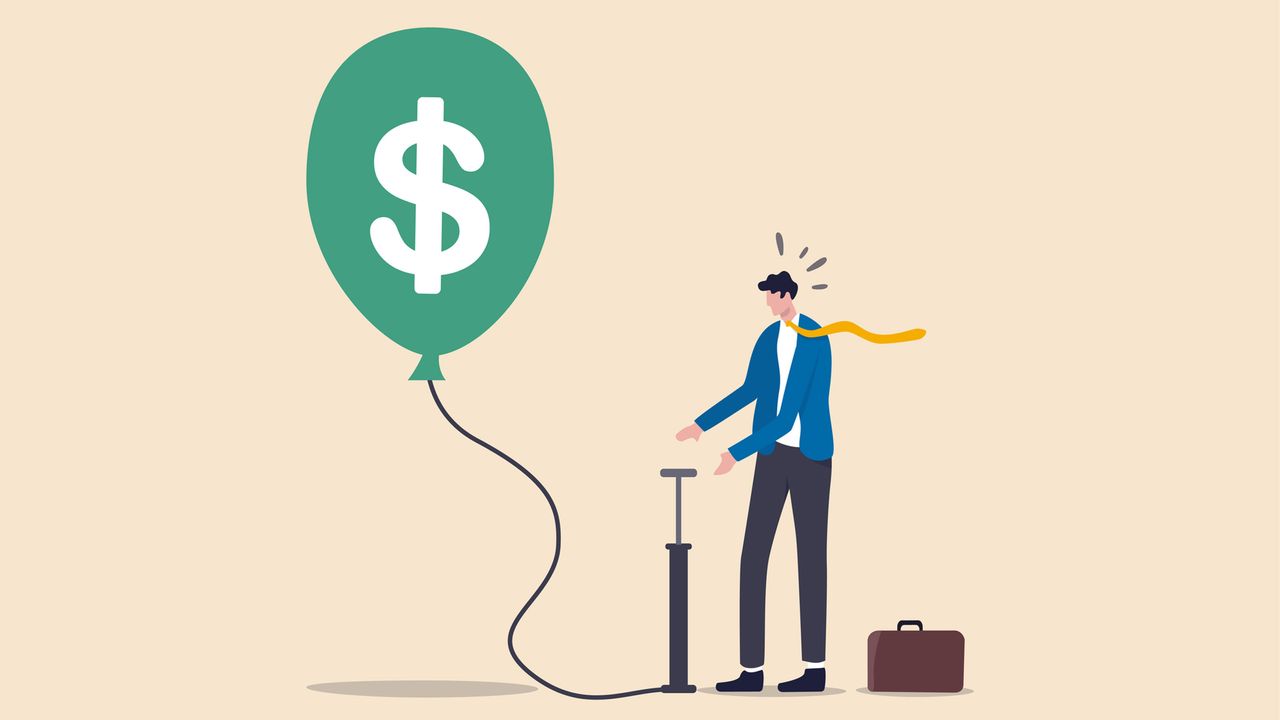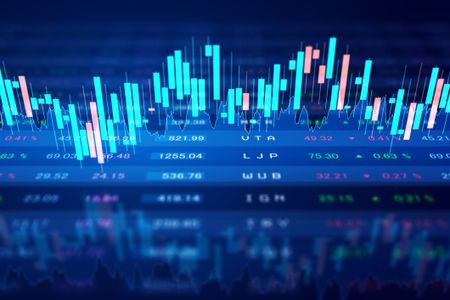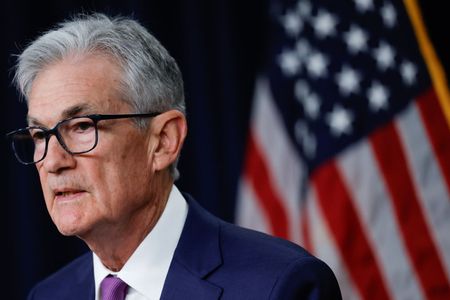Are Stocks in a Bubble?
Investors seeing signs of YOLO trading worry that the market is overinflated—and that the bubble is about to pop.

The stock market’s year-long boom has been accompanied by a familiar question on Wall Street, one that’s as old as the 17th century and as fresh as this spring’s tulips: Have stock prices been in a bubble destined to pop? Now, the bubble conversation has shifted to whether the air is seeping out, with major market indexes pulling back in March and the tech-heavy Nasdaq flirting with the 10% threshold that marks official correction territory. (Prices and returns in this article are as of March 5.)
Investors should not dismiss the chatter about whether an overinflated market has started to deflate. The Dutch tulip bulb mania in the 1600s wiped out fortunes. Euphoria during the Roaring Twenties led to the 1929 crash and Great Depression. The collapse of Japan’s asset bubble in 1991 resulted in decades-long stagnation. And the end of the internet-stock craze 20 years ago wiped out 80% of the Nasdaq’s value.
Although true bubbles tend to end badly, it’s possible that despite bouts of turbulence, especially in speculative pockets of the market, stocks this time around will resume their upward trajectory. We’ll share some strategies for this challenging market below. But it’s worth noting that bubbles can only be identified in hindsight, and we’re not there yet. Moreover, they can go on longer than you’d think. In late 1996, then–Federal Reserve chairman Alan Greenspan warned of “irrational exuberance,” but stocks kept rising until early 2000.

Sign up for Kiplinger’s Free E-Newsletters
Profit and prosper with the best of expert advice on investing, taxes, retirement, personal finance and more - straight to your e-mail.
Profit and prosper with the best of expert advice - straight to your e-mail.
The weight of the evidence. Bubbles form when irrational investors push prices up to unsustainable levels. The gains are driven by speculation, get-rich-quick thinking and adrenaline, rather than by time-honored investing fundamentals, such as profits, sales and valuation. Many experts blame a recent surge in speculation on a mountain of cash chasing returns. They point to the Federal Reserve’s easy-money policies and trillions of dollars that Congress has injected into the economy during the pandemic.
Whatever the reason, signs abound of excess, or what analysts call YOLO (you only live once) trading. Examples include video-game retailer GameStop’s social media–fueled boom (up 2,442% in intraday trading from the end of 2020 to January 28) and bust (down 92% by mid February); bitcoin’s 100% early-year gain; a surging market for initial public offerings; and Tesla’s brief run above $900 a share, which pushed the electric car maker’s market value to more than $800 billion—10 times greater than General Motors, the biggest U.S. automaker.
This mania reminds some veterans of investors’ infatuation with dot-com stocks in the 2000 bubble. “The crazy stuff we’re seeing today is no different,” says James Stack, editor of the InvesTech Research newsletter. It signals that risks are rising and that investors should tread carefully, he adds. Jeremy Grantham, cofounder of money management firm GMO, says this bull run will go down as “one of the great bubbles of financial history.”
A surefire way for the bubble to pop would be for the economy to overheat, causing inflation and bond yields to spike and forcing the Fed, which has said it will keep rates near zero through 2023, to raise rates sooner. The dive in early March that knocked some highfliers down 15%, 25% and more played out as Treasuries shot up to a one-year high of 1.6%—higher than the 1.5% yield of the S&P 500 index. Higher rates make stocks less attractive compared with bonds and exert downward pressure on growth stocks, whose profits in the future are seen as less valuable today when higher current interest rates get factored in.
But the bulls say the popping of a handful of mini bubbles will mostly cause localized pain in only the frothiest parts of the market—think stocks favored by day traders, such as GameStop, or cult stocks, such as Tesla. Also at risk are hot renewable-energy companies benefiting from momentum-trading strategies and high-growth stocks with high price-earnings multiples. “There are stocks and sectors that are bubbly right now, but I’m not sure that means the entire market is necessarily a house of cards,” says Ben Carlson, director of institutional asset management at Ritholtz Wealth Management. For now, still-low interest rates and a “stronger-than-expected vaccine-led economic restart” remain bullish market drivers, says Jean Boivin, head of BlackRock Investment Institute.
No matter where you come down on the current bubble debate, there are prudent ways to navigate a sometimes white-hot but often volatile market. “You want to make sure you have a plan,” says Kristina Hooper, chief global market strategist at money management firm Invesco. Here are four strategies to consider.
Focus on defense
To protect stock profits, trim your winners and move the proceeds into less-volatile investments. “In a market like this, you want to reduce risk” says Sam Stovall, chief investment strategist at investment research firm CFRA. The safest play is to park cash in a high-yielding money market account. Young folks have decades to ride out a market rout, but not people in or near retirement. “Losing 50% is not an option for a lot of people,” says InvesTech’s Stack.
Cash will not earn much interest, but it will not lose value and provides dry powder for when stocks go on sale. Online banks can offer plump yields—Ally Bank recently paid an annual percentage yield of 0.50% on its money market account. Take advantage of the 10-year Treasury note’s rising yield with iShares 7-10 Year Treasury Bond (symbol IEF, $114), an exchange-traded fund that owns Treasuries that mature in seven to 10 years and carries a 30-day SEC yield (a measure used to compare bond funds) of 1.03%.
You can also protect your portfolio by focusing on stocks with defensive traits. They include companies that increase their dividends every year, as well as value stocks, or those that trade cheaply relative to earnings, sales or other measures. Value stocks have rallied recently, but they posted smaller gains than growth stocks over the past decade. That means these stocks (think financials, some health care, industrials and other so-called cyclical companies that fare best when the economy is doing well) don’t have as far to fall as high-flying growth stocks.
Value stocks also have better profit outlooks for 2021, according to investment firm Credit Suisse, with earnings expected to increase 30% this year, compared with 21% for growth companies. Vanguard S&P 500 Value Index (VOOV, $133) is an ETF that owns Warren Buffett’s Berkshire Hathaway and JPMorgan. The index it tracks recently sported a price-earnings ratio of 18, a bargain compared with the comparable growth index’s P/E of 28.
Stocks that consistently boost dividends act as portfolio shock absorbers, with the dividend providing the cushion. S&P 500 Dividend Aristocrats are stocks that have increased their dividend payouts for 25 straight years. You can own many of them via two ETFs: ProShares S&P 500 Dividend Aristocrats (NOBL, 83) or SPDR S&P Dividend (SDY, $115).
Pivot with tactical shifts
This strategy involves positioning yourself for the next stage of the market cycle, and the next crop of market leaders, on the assumption that the market is at or near an inflection point. In this case, that means rotating into stocks that perform best when the economy is going gangbusters. But there’s no need for a complete portfolio do-over—think tweaks, “not all-in or all-out,” says Carlson, the Ritholtz money manager. According to BMO Capital Markets, since 1973, the best-performing sectors in the 12 months following a recession are companies that provide nonessential consumer goods or services—so-called consumer discretionary stocks (up 26%, on average, in the year following recessions), as well as materials producers (+23%), industrial companies (+19%) and financials (+15%).
Strategists at Credit Suisse recently compiled a list of “super cyclicals.” These are stocks whose prices are 2 to 2.5 times more sensitive to an economic acceleration than the broad market and, therefore, best positioned to benefit from the reopening trade. Stocks on the list recommended by the firm include equipment rental company United Rentals (URI, $301), FedEx (FDX, $257), hospitality companies including Wynn Resorts (WYNN, $133) and financial companies including Charles Schwab (SCHW, $65). In the same vein, Deutsche Bank in February upgraded its rating on all U.S. airlines to “buy.”
The U.S. market has been a longtime leader, but now is the time to consider investing overseas, in Europe and emerging markets, where valuations are cheaper, gains have been smaller and more stocks benefit from economic upturns. European businesses are more consumer-oriented, which bodes well if the restart is strong and demand picks up, says BlackRock’s Boivin. And European shares recently traded at an average P/E of 17.4, according to JPMorgan Asset Management, a 20% discount to U.S. shares. SPDR Portfolio Europe (SPEU, $38) is an ETF providing broad exposure to eurozone stocks.
Emerging-markets stocks also have room to run and will benefit from a global upswing. Consider Baron Emerging Markets (BEXFX), a Kiplinger 25 mutual fund.
Index-fund investors who want to steer their portfolio away from the mega-cap growth stocks that have had an outsize impact on the performance of the S&P 500, which weights stocks by market value, can consider an equal-weighted fund such as Invesco S&P 500 Equal Weight (RSP, $137), an ETF that gives equal weight to each of the S&P 500 stocks. The S&P 500’s top 10 stocks now account for 29% of the index’s market value and trade at an average P/E of 33, compared with an average of 20 for the other stocks. The equal-weighted fund has an advantage in market reversals because it will not be “dragged down by the behemoths,” says CFRA’s Stovall.
Play offense
If you believe the economy will enjoy a recovery brisk enough to offset rising rates, you have a high tolerance for volatility, and you are properly diversified, then bet on the market’s upward momentum. But be aware that bull market winners carry high P/Es and will fall the hardest when the market slumps, even temporarily. Case in point: Tesla’s 30% slide in the recent market pullback.
Daniel Ives, a technology analyst at Wedbush Securities, says the sell-off in tech has been overdone. “The tech party is just getting started,” says Ives, who sees the year ending with strong gains for the sector and advises investors to take advantage of buying opportunities and to stick with what has been working. That means big winners in the past year that remain well positioned to profit from longer-term trends, including tech stocks with dominant market shares, cloud-computing companies, newly public companies with big potential and beneficiaries of emerging trends, such as digitization, remote work and touchless payments. Ives’s picks include reasonably priced tech heavyweight Facebook (FB, $264), trading at a P/E of 24, as well as cloud play Microsoft (MSFT, $232), e-signature firm DocuSign (DOCU, $204) and 5G mobile network beneficiary Apple (AAPL, $121).
To reduce individual stock risk, invest in low-cost ETFs that offer some diversification. Top performers in the past year that own stocks benefiting from long-term business trends are now buy-the-dip candidates following declines of 10% to 25%. ARK Innovation (ARKK, $117), a Kiplinger ETF 20 pick, is an aggressive fund that invests in stocks in areas such as artificial intelligence, robotics and energy storage. A volatile market gives committed investors ample opportunity to add to positions when big price dips occur, which is exactly what Ark Investment Management CEO Cathie Wood, a Tesla bull, did in late February when the electric car maker fell more than 8% on two separate days. At the time, Wood told Bloomberg TV that investors were not recognizing the huge future market share Tesla is likely to command in the autonomous ride-sharing business.
If your goal is to own young upstarts, take a look at Renaissance IPO (IPO, $62), which invests in newly public companies. To tap into big-cap tech stocks that have been driving markets higher, consider Invesco QQQ (QQQ, $309), which tracks the 100 biggest non-financial Nasdaq stocks.
Investors not as comfortable with the highest-risk names can focus on tech stocks that are trading at P/Es more in line with the broad market and that will benefit more from supercharged economic growth. This year will see the fastest economic growth in more than 35 years, according to forecasts from Credit Suisse. In such an environment, semiconductor equipment makers Applied Materials (AMAT, $113) and Lam Research (LRCX, $548), as well as memory chip maker Micron Technology (MU, $89), are primed to perform better than mega-cap tech.
An aggressive playbook paid off in the 1990s when the Nasdaq rose 290% in the four years after Greenspan’s bubble warning. But stay disciplined. If tech darlings keep soaring, scale back holdings to avoid owning too big a helping of high-octane stocks. Also, be on the lookout for any signs of business weakness, such as unforeseen dips in sales or earnings that might call lofty valuations into question.
Stay the course
Long-term investors with little interest in tactical strategies who favor a diversified, buy-and-hold, largely hands-off approach can ignore the market’s daily drama as long as they execute the ABCs of personal finance. That means investing regularly, keeping your target weightings of stocks and bonds intact, and building a portfolio that lets you sleep at night. For most investors, that means keeping your portfolio on autopilot. Target-date funds adjust holdings for you, based on how close you are to retirement or savings goals, leaving portfolio tweaks to the pros. T. Rowe Price, Fidelity Investments and Vanguard offer a broad menu of these hands-off funds.
Or keep it simple with a few broadly diversified core holdings, such as low-cost, total-market index funds and ETFs that give you exposure to the broad U.S. or international stock markets, along with an aggregate or total-market bond fund that provides broad exposure to U.S. bonds.
Get Kiplinger Today newsletter — free
Profit and prosper with the best of Kiplinger's advice on investing, taxes, retirement, personal finance and much more. Delivered daily. Enter your email in the box and click Sign Me Up.
-
 Microsoft Stock: Innovation Spurs Its 100,000% Return
Microsoft Stock: Innovation Spurs Its 100,000% ReturnMicrosoft's ability to recognize the "next big thing" has allowed sales – and its share price – to grow exponentially over the years.
By Louis Navellier Published
-
 6 Great Vacation Ideas for Wheelchair Users
6 Great Vacation Ideas for Wheelchair UsersThese six places provide plenty of travel inspiration for people who use wheelchairs.
By Becca van Sambeck Published
-
 Fed Leaves Rates Unchanged: What the Experts Are Saying
Fed Leaves Rates Unchanged: What the Experts Are SayingFederal Reserve As widely expected, the Federal Open Market Committee took a 'wait-and-see' approach toward borrowing costs.
By Dan Burrows Published
-
 Fed Sees Fewer Rate Cuts in 2025: What the Experts Are Saying
Fed Sees Fewer Rate Cuts in 2025: What the Experts Are SayingFederal Reserve The Federal Reserve cut interest rates as expected, but the future path of borrowing costs became more opaque.
By Dan Burrows Published
-
 Fed Cuts Rates Again: What the Experts Are Saying
Fed Cuts Rates Again: What the Experts Are SayingFederal Reserve The central bank continued to ease, but a new administration in Washington clouds the outlook for future policy moves.
By Dan Burrows Published
-
 Fed Goes Big With First Rate Cut: What the Experts Are Saying
Fed Goes Big With First Rate Cut: What the Experts Are SayingFederal Reserve A slowing labor market prompted the Fed to start with a jumbo-sized reduction to borrowing costs.
By Dan Burrows Published
-
 Stock Market Today: Stocks Retreat Ahead of Nvidia Earnings
Stock Market Today: Stocks Retreat Ahead of Nvidia EarningsMarkets lost ground on light volume Wednesday as traders keyed on AI bellwether Nvidia earnings after the close.
By Dan Burrows Published
-
 Stock Market Today: Stocks Edge Higher With Nvidia Earnings in Focus
Stock Market Today: Stocks Edge Higher With Nvidia Earnings in FocusNvidia stock gained ground ahead of tomorrow's after-the-close earnings event, while Super Micro Computer got hit by a short seller report.
By Karee Venema Published
-
 Stock Market Today: Dow Hits New Record Closing High
Stock Market Today: Dow Hits New Record Closing HighThe Nasdaq Composite and S&P 500 finished in the red as semiconductor stocks struggled.
By Karee Venema Published
-
 Stock Market Today: Stocks Pop After Powell's Jackson Hole Speech
Stock Market Today: Stocks Pop After Powell's Jackson Hole SpeechFed Chair Powell's Jackson Hole speech struck a dovish tone which sent stocks soaring Friday.
By Karee Venema Published